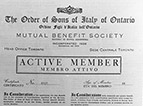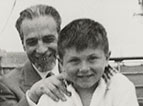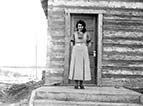Key People, Places & Terms
Adolf Hitler (1889-1945): The leader of the Nazi Party (1920-1945), he was appointed Chancellor of Germany in 1933 and became President in 1934. Under his leadership, Germany rearmed itself and invaded Poland in September 1939 sparking World War II. Hitler and the Nazi Party’s anti-Semitism led to the systematic and state-sponsored murder of roughly 6 million Jews, known as the Holocaust. Other victims of the Nazi death camps included Soviet prisoners of war, homosexuals, Roma, Polish civilians, people with disabilities, and political opponents. Hitler committed suicide in 1945 after Soviet forces entered Berlin.
Adrien Arcand (1899-1967) & National Unity Party (NUP) (1934-1940): A Montreal-based journalist and activist who led a handful of fascist groups throughout his life – most notably the National Unity Party (NUP). He was a supporter of Adolf Hitler and shared the dictator’s anti-Semitic views. Arcand and other members of the NUP were interned during World War II.
Benito Mussolini (1883-1945): A former socialist who became a nationalist and militarist fascist over the course of World War I. Mussolini was also one of the founding members of the Partito Nazionale Fascista (PNF). As the PNF became more powerful, Italian King Vittorio Emanuele III invited Mussolini to form a government. This led to a 21 year reign as Il Duce. Following the Allied invasion of Italy in the summer of 1943, he was imprisoned only to be freed by German special forces and installed as the Head of State for the Italian Social Republic – an area of Italy under German occupation – headquartered at Salò, Lombardy. In April 1945, Mussolini was forced to flee Salò due to the advance of the Allies. While trying to flee to Switzerland, he was captured by Italian partisans, executed, and taken to Milan where his body was hung from a gas station to confirm that he was dead.
Canadian Security Intelligence Service (CSIS): The Canadian Security Intelligence Service (CSIS) was created in 1984. It is responsible for protecting Canada’s national security from internal and external threats. Its primary role is that of intelligence rather than law enforcement, conducting national security investigations and collecting security intelligence both in Canada and abroad.
Casa d’Italia: An Italian social and political centre that housed fascist organizations such as the dopolavoro, Gioventù Italiana del Littorio Estero, and the local fascio. Casa d’Italias also provided offices for the Order Sons of Italy, musical bands, and theatre groups. These buildings were constructed during the fascist years and often displayed fascist symbols. The Hamilton Casa d’Italia, for example, had the symbol of the fasces (bundle of sticks) built into the floor.
Communism: A political, social, and economic movement on the left of the political spectrum that seeks to create a classless – and ultimately stateless – society where waged labour and private property would not exist and all land, resources, and manufactured items would be shared in common.
Consular: Is the word used to describe the services that a country provides for its citizens abroad. This network includes embassies, high commissions, and consulates headed by honorary consuls – in this context, an Italian political representative working as the president of a consular office. These offices provide different levels of services to immigrants abroad, including, but not limited to, passport services, citizenship papers, repatriation services, studying in Italy services, etc.
Custodian of Enemy Property (CEP): A branch of the Canadian government that oversaw the administration of assets belonging to internees and other enemy aliens. Hon. Pierre Casgrain was the Custodian of Enemy Property, and also the Secretary of State. The office served a dual function. Acting as a trustee for the internee/enemy alien, the office and its agents also protected the interests of the creditors. The CEP would pay off an internee’s debts by selling his or her property or businesses. It also collected money owed to internees by others. Each accounting firm hired by the CEP would bill an internee for administrative costs even though internees did not ask for the CEP to be involved.
Dopolavoro: A fascist recreational and social organization created in 1925 to challenge socialist cultural leagues in Italy. The dopolavoro provided sporting and outdoor activities to its members as well as libraries stocked with fascist literature. The purpose of the dopolavoro was to turn Italians into supporters of the fascist movement and find potential recruits for the fascio. However, many members joined for the leisure activities and not necessarily for the fascist politics. Though it was created in Italy, the dopolavoro was exported to countries where Italian communities existed. In Canada, the dopolavoro was overseen by Italian consular officials.
Enemy Alien: The term commonly used in relation to individuals of nations at war with Canada and living in Canada during World War II. In this context, It referred to Italian citizens and those Italians who had been born in Italy, but were naturalized as British subjects after September 1, 1922. In some cases, even Canadian-born Italians were designated as enemy aliens. As such, individuals had to report to local Royal Canadian Mounted Police (RCMP) detachments once a month.
Ethiopian War (1935-1936): The war, officially known as the Second Italo-Abyssinian War, began on October 3, 1935 when Italian forces from Eritrea invaded Ethiopia (formerly Abyssinia). Although both countries were members of the League of Nations, the organization was slow to impose sanctions on Italy and lacked the strength to enforce these sanctions. On May 5, 1936 when Italian forces captured the capital of Addis Ababa, all sanctions were dropped and Ethiopia was merged with other Italian colonies and became Italian East Africa. Italian East Africa was disassembled by the Allies in 1943.
Fascio: A group related to the Fascist Party of Italy in its mandate and funding, and tied to the work of the Italian diplomatic representatives of that time in Canadian cities and towns. A fascio was often named after someone of significance to the fascist movement. Vancouver’s Circolo Giulio Giordani, for instance, took its name from a rightwing lawyer and decorated veteran of the World War I who was killed in a gunfight between fascists and socialists.
Fascio Femminile: The women's section of the fascio.
Fifth Column: The term originated in 1936 when Emilio Mola (1887-1937), a Nationalist General during the Spanish Civil War (1936-1939), noted that the four columns of his forces outside Madrid would be supported by a "fifth column" of his supporters inside the city. The term was used extensively in Britain in the early stages of World War II to explain the internment of German nationals, and subsequently was used in the United States and Canada.
Franklin D. Roosevelt (1882-1945): The 32nd President of the United States (1933–1945). Officially the United States remained neutral at the outset of World War II until the bombing of Pearl Harbour by the Japanese on December 7, 1941. After this date Roosevelt worked closely with Winston Churchill of the United Kingdom and Russia’s Joseph Stalin (1878-1953) in leading the Allies against Germany and Japan in World War II.
Giacomo Matteotti (1885-1924): An Italian socialist elected to the Italian Chamber of Deputies. He was an outspoken critic of fascism. In 1924, Matteotti was kidnapped and killed by fascists.
Giovanni Giolitti (1842-1928): Elected Prime Minister of Italy five times between 1892 and 1921. Described as a left-leaning liberal, Giolitti's time in office led to social reforms, infrastructure projects and the nationalization of the phone system and the railway. Giolitti also attempted to co-opt political opponents by inviting them to run on the same ticket. He did this first with the socialists and later the fascists.
Gioventù Italiana del Littorio Estero (GILE): Was the foreign branch of the GIL, a fascist youth organization established by the PNF in Italy on October 29, 1937. Organized under military discipline, the GILE sought to instill a love of Italy among youth and develop future generations of fascists. It provided recreational activities to both boys and girls ranging in age from 6 to 18.
Giuseppe Mazzini (1805-1872): An Italian politician and activist who was instrumental in the unification of Italy. From an early age, Mazzini believed Italy should be a unified democratic republic. He is often referred to in literature as the “soul of Italy”.
Internment Camp vs. Concentration Camp: The term concentration camp was used to refer to any camp where large numbers of civilians were held. Following World War II, a concentration camp referred specifically to those camps created by the Nazis to exterminate Jews, Roma, Communists, and others. Internment camp was then used to distinguish prisoner of war and other camps from the Nazi death camps.
Italian Canadian: In many ways Italian Canadian is a problematic term. During World War II, Canadian citizenship did not exist and those who had been born in Canada or who had been naturalized were British subjects. In addition, some of those who were interned or required to report regularly to police retained their Italian citizenship. We have chosen to use the term Italian Canadian to include all Italians living in Canada in the 1940s prior to the creation of Canadian citizenship in 1947.
James Duncan Hyndman (1874-1971): A former judge of the Supreme Court of Alberta appointed by the Canadian Minister of Justice to review the cases of internees who objected to their internment.
King Vittorio Emanuele III (1869-1947): A member of the House of Savoy and King of Italy who reigned from July 29, 1900 to May 9, 1946. He invited Benito Mussolini to form a government in 1922.
Lateran Accords: Three agreements between the Kingdom of Italy and the Holy See that were ratified on June 7, 1929. The Lateran Accords led to the Vatican becoming an independent state, affirmed Catholicism as the state religion of Italy, and began the settlement of claims by the Holy See for loss of property and territory.
League of Nations: An international organization created after World War I, to prevent war and settle international disputes. The covenant was signed in 1919 by the 32 participating nations and stated that an attack on another League member would be considered an attack on all members and result in joint action against the aggressor. The League was replaced by the United Nations in 1946.
March on Rome: The march was carried out by members of the Partito Nazionale Fascista that occurred from October 22 to 29, 1929. This show of force on the part of the fascists resulted in Benito Mussolini being asked to govern by King Vittorio Emanuele III.
Order of Italian Canadians: A benevolent society created in 1929 in Montreal. It was comprised of antifascist lodges that had left the Order Sons of Italy due to increasing fascist interference.
Order Sons of Italy: Founded in 1905 by Dr. Vincent Sellaro (1868-1932) in New York City, it operated as a mutual aid society for those of Italian origin. The first Canadian lodge of this fraternal organization was founded in Sault Ste. Marie in 1915. Fascists attempted to take control of this organization in the 1930s.
Organizzazione per la Vigilanza e la Repressione dell'Antifascismo (Organization for Vigilance and Repression of Anti-Fascism, OVRA): Founded in 1927, the organization served as the secret police under the Italian fascist government. Paid agents were suspected of infiltrating other organizations and groups to report on and stop any anti-Fascist activity or work.
Paesani: A term used to describe persons originating from the same village in Italy. Sometimes this can be extended to include a larger area or region in Italy, for example, two people with origins in different towns in the Abruzzo region may refer to one another as paesani. The latter definition of the term is most prevalent among Italian immigrants.
Partito Nazionale Fascista (National Fascist Party): The fascist political party led by Benito Mussolini that ruled Italy from 1922 to 1943.
Risorgimento: Known as the Resurgence in English, the Risorgimento was the violent process that unified the separate kingdoms of the Italian Peninsula into a unified state in 1861.
Royal Canadian Mounted Police (RCMP): Was formed in 1920 by the merger of the Royal Northwest Mounted Police (RNWMP, founded 1873) with the Dominion Police (founded 1868) and is the national police force of Canada. Prior to 1984 the RCMP Security Service branch oversaw specialized political intelligence and counterintelligence, until it was replaced with the Canadian Security Intelligence Service (CSIS).
Security Certificate: The current means with which the Canadian government can deport non-citizens considered a threat to national security.
Socialism: A political philosophy that advocates for an economic system where the means of production are owned in common or by the state. Socialism also seeks a more equitable and non-hierarchical form of social organization.
La Società di Mutuo Soccorso la Trinacria: A benevolent society established by Italian migrants from Sicily, one of the oldest Italian organizations in Toronto.
Treaty of Versailles: This treaty was signed between Germany and the Allies on June 28, 1919, and ended World War I. The treaty resulted in Germany accepting sole responsibility for the conflict and required the country to pay large reparations and disarm.
William Lyon Mackenzie King (1874-1950): The longest-serving Canadian Prime Minister; he served three terms between 1921 and 1948. He was leader of the Liberal Party from the 1920s through to the 1940s, and led Canada through World War II. In 1937, King was the only North American head of government to visit Germany and meet with Adolf Hitler. In the 1930s when Germany began to rearm herself, King informed the British government that Canada would remain neutral and would only go to war if Britain was directly attacked. However, in August of 1939, King realized that war on a larger scale was imminent and began to mobilize Canadian troops. During the war King worked closely with Roosevelt ensuring close cooperation of Canadian and American forces.
Winston Churchill (1874-1965): In the years leading up to World War II, Churchill was outspoken about the danger posed by Adolf Hitler and the need for Britain to begin to rearm herself. When war eventually broke out he was appointed First Lord of the Admiralty, a role he held during World War I. On May 10, 1940 Prime Minister Neville Chamberlain (1869-1940) officially resigned and Churchill became Conservative Prime Minister and lead the United Kingdom through World War II.



